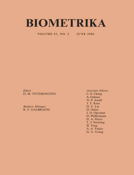-
Views
-
Cite
Cite
Adin-Cristian Andrei, Susan Murray, Estimating the quality-of-life-adjusted gap time distribution of successive events subject to censoring, Biometrika, Volume 93, Issue 2, June 2006, Pages 343–355, https://doi.org/10.1093/biomet/93.2.343
Close - Share Icon Share
Abstract
When treatment effects are studied in the context of successive or recurrent life events, separate analyses of the quality-of-life scores and of the inter-event, gap, times might lead to possibly contradictory conclusions. In an attempt to reconcile this, we propose a unitary and more comprehensive nonparametric analysis that combines the two separate analyses by introducing the quality-of-life-adjusted gap time concept. Inverse probability of censoring estimators of the quality-of-life-adjusted gap time joint and conditional distributions are proposed and are shown to be consistent and asymptotically normal. Simulations performed in a variety of scenarios indicate that the joint and conditional quality-of-life-adjusted gap time distribution estimators are virtually unbiased, with properly estimated standard errors and asymptotic normality features. An example from the International Breast Cancer Study Group Trial V illustrates the use of the proposed estimators.



